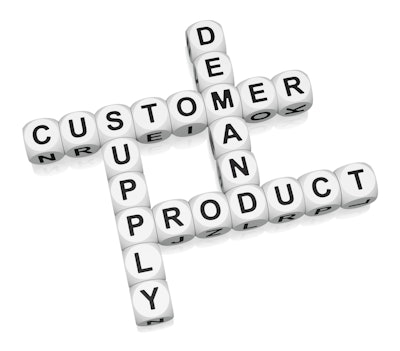
For many consumer goods (CG) companies, “becoming demand-driven” requires a significant break from the past. The organization must leave behind its legacy processes and embrace a new way of approaching the supply chain. The first questions to be answered are: What does it mean to be demand-driven, and what are the benefits to our organization?
Being demand-driven, in its most basic form, means thinking about your business from the outside in, understanding what the market wants and determining how you will satisfy that demand. As simple as this may sound, it can be a difficult concept to execute. Decades of manufacturing-as-usual and pushing products to market has engrained our attitude toward efficiency and output. All we care about is how much product can we produce and how efficiently can we bring that product to market?
Being demand-driven means figuring out how to accurately perceive and satisfy the demand that exists, using all available resources, products, production capacity, and our distribution network. Here the market pulls goods from CG manufacturers.
Impact on Products
The pace of new product introductions (NPIs) in CG places pressure on supply chain organizations to collaborate with sales, marketing, finance, operations, etc. to develop an accurate plan that ensures the right product arrives at the right place for the right price at the right time.
The shift to a demand-driven philosophy impacts the CG product portfolio. For example, a traditional inside-out plan would look at a portfolio of 14 product families and develop a plan to push these out to the market. In a demand-driven organization, we first take a look at how many product families the market can absorb, and which products will sell at quantities that are profitable. This approach could drive the 14 product families initially planned down to 12 or 11, based on what the market can absorb.
Impact on Customers
Consumer goods companies often look at customer-specific demand (for example a retailer) instead of demand in aggregate. To become demand-driven requires the ability to segment customers, know which 10 or 20 customers contribute the most to our bottom line, and ensure we can satisfy their needs. This information lets us develop a plan that meets the service level agreements in place.
Impact on Channels
Consumers today are buying product through multiple channels, from retail to wholesale to online and direct from the manufacturer. Both the mix of channels and the capabilities to serve the channels profitably are critical to success. As channel complexity grows it is important to look at the demand for each product through each channel, as opposed to determining demand for each independently. We must develop the demand-driven capability to slice and dice and evaluate based on more than just a volumetric or financial measure.
I Know My Demand, Now What?
When we understand demand for a period of time, we can take two key steps:
1) Determine if the demand is being realized at the expected pace, or if demand needs to be stimulated. Demand sensing techniques can quickly determine how we are performing against plan and indicate when sales and marketing effort is needed to influence consumer behavior.
2) De-emphasize the outbound point-of-view. Historically, CG companies have thought about planning product from a ship-from point-of-view. Today, demand-driven companies plan based on a ship-to process. Where will customers need our product? For example, selling through a national retail chain with seven distribution centers leads us to look at the demand for each distribution center and the most profitable path to deliver the product there. From this information, we set smarter inventory policies as well as supply and replenishment strategies.
A Change in Philosophy
As our business philosophy changes and we start to look at demand from the outside-in, the strategy begins to change. Smaller, more frequent shipments are required for some customers while others may see better results from special pack sizes that facilitate the rapid movement of goods through the distribution center. We see this shift occur often in the apparel and footwear market where each retail location may receive a different assortment of styles, sizes, colors, etc. To help facilitate this demand, special packs and labeling can help facilitate the distribution.
In another example, retailers such as home improvement centers may require unique packaging or the inclusion of accessories that help differentiate a product in its store from the same product in another. For CG manufacturers this means holding two distinct inventories for very similar products. As a consumer goods company, you need to evaluate complex inventory investments based on the pull through of that particular customer. You need to compare multiple scenarios that will allow you to bring together your strategic goal of being demand-driven.
The Proof is in the Pudding
Demand-driven organizations receive significant benefits. While there may be greater inventory stratification, inventory significantly lowers across the network, including obsolete inventory. Lower inventory investment allows CG companies to turn around and reinvest the savings into NPIs and expanding into new markets.
Demand-driven organizations also see an improvement in forecast accuracy. With a more focused approach to evaluating demand and the products required to satisfy that demand, accuracy increases. This has a waterfall effect across the supply chain. With a better predictor of demand you can better align inventory and supply, position inventory accurately, and utilize your production and distribution assets more effectively.
Another area where CG companies are achieving significant gains is in customer service. With clear visibility to specific customer level demand for a product, you are able to more profitably meet their needs when and where they want it.
New products create risk for CG companies and can disrupt the production and distribution of well-established products. Becoming demand-driven allows companies to knock down organizational silos and create an integrated planning platform that ensures all teams involved are aligned and working toward the same goal – the company’s ability to profitably satisfy demand.
The road to become demand-driven is not an overnight excursion; this journey requires a change in mindset, a change in process and an excellent technology foundation to make it happen.



















